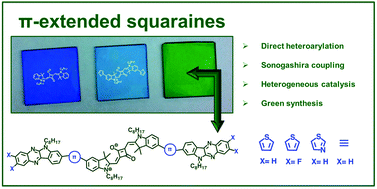Optimized synthesis of π-extended squaraine dyes relevant to organic electronics by direct (hetero)arylation and Sonogashira coupling reactions†
Abstract
This study reports on the synthesis and characterization of four molecular π-extended squaraine compounds relevant to the field of organic electronics. The compounds each consist of a bis-indole squaraine core end-capped with indoloquinoxaline units employing three different bridging units, namely thiophene, thiazole, and acetylene. Compound 10 bears a thiophene bridge, 11 consists of a thiophene bridge and fluorinated indoloquinoxaline terminal units, and compounds 12 and 13 are bridged by thiazole and acetylene, respectively. The final compounds are constructed using the atom economical direct (hetero)arylation or the classic Sonogashira carbon–carbon bond formation protocols. Each carbon–carbon bond forming reaction employing thiophene bridges (i.e. synthesis of compounds 10 and 11) has been optimized using the stable and reusable silica supported Pd catalyst, SiliaCat® DPP-Pd, streamlining the synthetic procedure. While compounds 12 and 13 were also accessible using the SiliaCat® DPP-Pd catalyst, the use of Herrmann–Beller and Pd(PPh3)4 catalysts, respectively, lead to improved isolated yields of the final materials. Compounds 10–13 were characterized by thermal gravimetric analysis, cyclic voltammetry, optical absorption spectroscopy, photoluminescence spectroscopy, and each structure was analysed using density functional theory. All compounds exhibit high thermal stability and good solubility in common organic solvents, including in the greener alternative 2-methyl tetrahydrofuran. The reported compounds display stable ambipolar redox behaviour, furthermore, we have demonstrated that the frontier molecular energy levels can be effectively tuned by changing the bridging unit as predicted by density functional theory. Most striking is the drastic optical absorption profile changes observed from this class of materials upon post-deposition film annealing, suggesting molecular rearrangement in the solid-state. The induced changes and fine structure observed upon post-deposition annealing is unique to these π-extended squaraines with nothing like it reported in the literature for related squaraine based materials.

- This article is part of the themed collection: CSC100: Celebrating Canadian Chemistry


 Please wait while we load your content...
Please wait while we load your content...